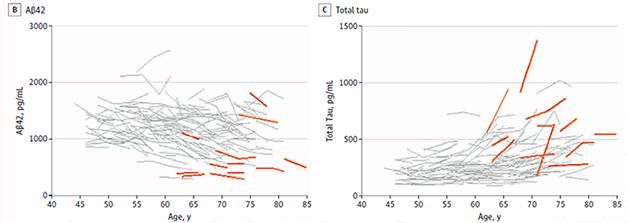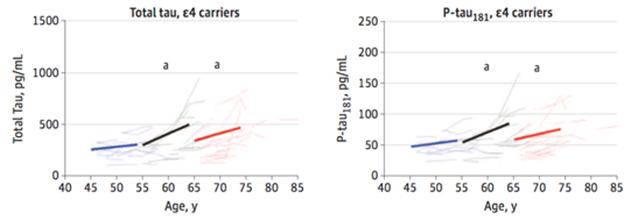Midlife CSF Crisis? Markers May Herald Future AD
Quick Links
A protein signature of Alzheimer’s could emerge as soon as early middle age, suggests a study led by Anne Fagan, Washington University School of Medicine, St. Louis. In the July 6 JAMA Neurology, Fagan and colleagues report longitudinal trends in cerebrospinal fluid (CSF) markers and brain amyloid in cognitively healthy volunteers. People as young as 45 had profiles that could portend dementia.
“We have learned a lot about AD pathogenesis by studying biomarkers in cross-sectional studies,” wrote Kaj Blennow, University of Gothenburg, Sweden. “The key in this study is the longitudinal data. Given that we might have anti-Aβ disease-modifying drugs in the near future, these findings are important.”
Previous cross-sectional studies have detected ups and downs in AD-related biomarkers—especially Aβ42 in the CSF and amyloid in the brain—when people are about 50 years old (May 2015 news; Peskind et al., 2006). These changes occur about 20 to 30 years before Alzheimer’s symptoms are apparent, but how early they begin has not been clearly determined. Longitudinal studies in familial AD suggest that CSF Aβ42 begins to fall as early as 25 years before onset in AD mutation carriers, and cerebral amyloid pathology begins to accumulate 15 years earlier (Bateman et al., 2012). Fagan and colleagues wondered how far back in life those changes start for people at risk for late-onset disease. They also wondered at what age clear longitudinal changes in marker levels might emerge. That knowledge could help clinicians establish prevention trial selection criteria.
First author Courtney Sutphen and colleagues examined data from middle-aged enrollees in the Adult Children Study at WashU. Volunteers in this study have parents who had AD, and are considered at increased risk for dementia. All were cognitively healthy at baseline, though 61 carried at least one copy of the ApoE4 allele, a genetic risk factor for AD. Between January 2003 and November 2013, 169 of these participants gave a sample of cerebrospinal fluid (CSF) every three years. Some gave a total of two samples, others three or four. At each visit, a clinician assessed their clinical dementia rating (CDR). Serial positron emission tomography amyloid scans with Pittsburgh compound B (PiB-PET) were taken for 74 of the subjects. The researchers divided the volunteers into early (age 45 to 54), mid (55 to 64), and late (65 to 74) middle age bins for analysis.
Using ELISA, Sutphen and colleagues determined whether CSF levels of Aβ40, Aβ42, total tau, and tau phosphorylated at position 181 (p-tau181) changed over time. They also examined two more recently proposed Alzheimer’s biomarkers: visinin-like protein 1 (VILIP-1), a marker of neuronal death, and chitinase-3-like protein 1 (YKL-40), which indicates gliosis and neuroinflammation (Tarawneh et al., 2011; Craig-Schapiro et al., 2010).
In people whose biomarkers changed, the researchers saw a stereotypical progression. First, CSF Aβ dropped, sometimes as far back as early middle age. In mid middle age, people with lower CSF Aβ42 levels tested positive on PiB-PET scans. Then in mid to late middle age, total and p-tau181 crept up, along with VILIP-1. YKL-40 rose over time in all age groups. All of these biomarker changes were more pronounced, and occurred earlier, in people carrying one copy of the ApoE4 allele, and more so for those with two.
Fourteen people in the cohort scored 0.5 or higher on the CDR at some point in the study, indicating that their cognition had started to decline. Most of these people had low Aβ42 measurements from baseline and high total tau later on (see image below). The authors suggest that these biomarker changes foretell dementia, but write that they will need to follow these people further to test that hypothesis.

People whose cognition declined (orange) had generally low or falling Aβ42 (left) and rising total tau levels (right). [©2015 American Medical Association.]
Sutphen pointed out that some of the youngest participants in this study already fell below the cutoff for Aβ42 positivity—1041 pg/mL—at baseline, implying that their CSF levels dropped at even younger ages. “It looks like we may need to go earlier than 45 to catch the very beginning of Aβ42 changes,” Sutphen told Alzforum. She also explained that the ultimate goal is to be able to predict who will develop dementia on an individual level to help decide who would benefit from anti-amyloid therapy. The authors noted that the CSF Aβ levels fall before PiB-PET scans become positive, meaning CSF levels could be an earlier biomarker for AD.
The author made some other interesting observations. For example, total tau rose more slowly in late middle age than mid middle age in ApoE4 carriers (see image below). The authors interpreted this to mean that either neurodegeneration slows at older ages, after an initial phase of rapid neuronal die-off, or that something disrupts the normal pattern of secretion of these proteins in older age. Fagan reported that CSF tau eventually dropped in people enrolled in the DIAN study of familial AD, but those volunteers had symptomatic disease (see Mar 2014 news). Clifford Jack of the Mayo Clinic in Rochester, Minnesota, said that alternatively, the slower rise in tau in the older group could result from a cohort effect, whereby those in late middle age happened to be cognitively normal, have little neurodegeneration, and hence produce less CSF tau. They may just be biologically different from the people who started the study when they were 10 years younger, he said.

Faster in the Middle: Among ApoE4 carriers, CSF tau climbed on average more slowly in late middle age (red) than in mid middle age (black). [©2015 American Medical Association.]
Pieter Jelle Visser, VU University Medical Center, the Netherlands, pointed out that overall the data support the idea that the ApoE4 allele has an impact on markers of neuronal injury as well as amyloid-related ones. He also agreed with the authors that the results relating these biomarker changes to dementia are preliminary, and require longer follow-up and more rigorous statistical analysis.—Gwyneth Dickey Zakaib
References
News Citations
- Meta-Analyses Deliver Most Definitive Data Yet on Amyloid Prevalence
- DIAN Longitudinal Data Surprises With Late Drop in Tau
Paper Citations
- Peskind ER, Li G, Shofer J, Quinn JF, Kaye JA, Clark CM, Farlow MR, Decarli C, Raskind MA, Schellenberg GD, Lee VM, Galasko DR. Age and apolipoprotein E*4 allele effects on cerebrospinal fluid beta-amyloid 42 in adults with normal cognition. Arch Neurol. 2006 Jul;63(7):936-9. PubMed.
- Bateman RJ, Xiong C, Benzinger TL, Fagan AM, Goate A, Fox NC, Marcus DS, Cairns NJ, Xie X, Blazey TM, Holtzman DM, Santacruz A, Buckles V, Oliver A, Moulder K, Aisen PS, Ghetti B, Klunk WE, McDade E, Martins RN, Masters CL, Mayeux R, Ringman JM, Rossor MN, Schofield PR, Sperling RA, Salloway S, Morris JC. Clinical and biomarker changes in dominantly inherited Alzheimer's disease. N Engl J Med. 2012 Aug 30;367(9):795-804. PubMed.
- Tarawneh R, D'Angelo G, Macy E, Xiong C, Carter D, Cairns NJ, Fagan AM, Head D, Mintun MA, Ladenson JH, Lee JM, Morris JC, Holtzman DM. Visinin-like protein-1: diagnostic and prognostic biomarker in Alzheimer disease. Ann Neurol. 2011 Aug;70(2):274-85. PubMed.
- Craig-Schapiro R, Perrin RJ, Roe CM, Xiong C, Carter D, Cairns NJ, Mintun MA, Peskind ER, Li G, Galasko DR, Clark CM, Quinn JF, D'Angelo G, Malone JP, Townsend RR, Morris JC, Fagan AM, Holtzman DM. YKL-40: a novel prognostic fluid biomarker for preclinical Alzheimer's disease. Biol Psychiatry. 2010 Nov 15;68(10):903-12. PubMed.
Further Reading
Papers
- Ouwens DM, van Duinkerken E, Schoonenboom SN, Herzfeld de Wiza D, Klein M, van Golen L, Pouwels PJ, Barkhof F, Moll AC, Snoek FJ, Teunissen CE, Scheltens P, Diamant M. Cerebrospinal fluid levels of Alzheimer's disease biomarkers in middle-aged patients with type 1 diabetes. Diabetologia. 2014 Oct;57(10):2208-14. Epub 2014 Jul 18 PubMed.
- Ritchie CW, Ritchie K. The PREVENT study: a prospective cohort study to identify mid-life biomarkers of late-onset Alzheimer's disease. BMJ Open. 2012;2(6) PubMed.
Primary Papers
- Sutphen CL, Jasielec MS, Shah AR, Macy EM, Xiong C, Vlassenko AG, Benzinger TL, Stoops EE, Vanderstichele HM, Brix B, Darby HD, Vandijck ML, Ladenson JH, Morris JC, Holtzman DM, Fagan AM. Longitudinal Cerebrospinal Fluid Biomarker Changes in Preclinical Alzheimer Disease During Middle Age. JAMA Neurol. 2015 Sep;72(9):1029-42. PubMed.
Annotate
To make an annotation you must Login or Register.

Comments
University of Goteborg, Sahlgrenska University Hospital
This is yet another important paper from the Washington University group on the very early evolution of pathogenic processes in AD.
We have learned a lot about AD pathogenesis by studying AD biomarkers in cross-sectional studies, often with clinical follow-up, but the key in this study is its longitudinal nature, with repeated biomarker evaluations. This may make it possible to identify when, and in what order, biomarkers change from normal, i.e., it could tell us when, during the preclinical phase, the different pathogenic processes evolve.
Indeed, Fagan and colleagues show that CSF levels of Aβ42 (with reductions known to reflect plaque pathology) may decline as early as around 50 years of age in cognitively normal persons, and that reductions in somewhat older people (around 60 years of age) can be directly linked to brain amyloid deposition (evaluated by amyloid PET scans). Increases in neuronal markers, such as tau, come somewhat later.
Given that we might have anti-Aβ-disease-modifying drugs in the near future, these findings are of great importance. A scenario that may not be too speculative is that these biomarkers may be used for screening purposes, with either abnormal values, or a clear change seen on repeated sampling, used as indications of when to begin treatment. It is easy to draw parallels with other diseases where biomarkers are used for screening in middle age, such as hypercholesterolemia (serum-cholesterol) and diabetes type II (plasma-glucose).
Make a Comment
To make a comment you must login or register.